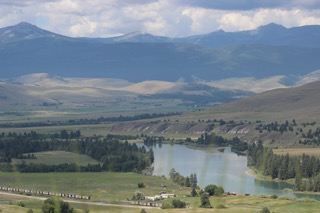
We have a member of our community looking for individuals/families who purchased property or inherited property that did not have water rights filed by 1982. Many of the individuals felt it was better to have a land patent instead of a water right so they did not file and now they have to fight for their water.
If you are one of these individuals who have a land patent and did not have water rights filed by 1982, please send me the following:
- The full name of the land owner(s)
- The address of the land/water in jeopardy – include city and zip please
- Phone Number including area code
- email address.
If you send me the above information, I will forward your information to the individual asking to collect the information. She is working with members of the state legislature to fight this. We need to attack the compact on numerous fronts – this is another one that will help! JR jmreffner@gmail.com
16 August 2023 Crypto & the Tribe
1 August 2023: The Cancer of Government Deemed “Self-Determination
Saturday, 22 July 2023: Greg and Steve are at it again
Video: Ph.D. Hydrogeologist BLAMES CSKT Water Compact for Low Flathead Lake Levels
17 July 2023 Politics of Lake Draw Down
17 July 2023 | MONDAY: Flathead Lake Levels: Part of a MUCH Larger Problem
13 July 2024: What Happens if the Compact Gets a Thumbs Down?
11 July 2023 The Bigger Picture: Please Don’t Lose Sight of IT!
9 July 2024 Response to a Commenter
19 May 2023 FRIDAY: Tim Orr letter to Editor
Montana Water Compact Gives Away Our RIGHTS! by Bret Bailey
6 December 2022 Water Court Posts Objections
The CSKT Compact, Montana Water Rights Protection Act:
Similar Federal Actions; and Making it Work for Montana
Montana Land and Water Alliance
US CONSTITUTION
Article VI. Debt. The Constitution, Laws, and Treaties are the supreme Law of the Land. Operative word is “and”:
All Debts contracted and Engagements entered into, before the Adoption of this Constitution, shall be as valid against the United States under this Constitution, as under the Confederation.
This Constitution, and the Laws of the United States which shall be made in Pursuance thereof; and all Treaties made, or which shall be made, under the Authority of the United States, shall be the supreme Law of the Land; and the Judges in every State shall be bound thereby, any Thing in the Constitution or Laws of any State to the Contrary notwithstanding.
The Senators and Representatives before mentioned, and the Members of the several State Legislatures, and all executive and judicial Officers, both of the United States and of the several States, shall be bound by Oath or Affirmation, to support this Constitution; but no religious Test shall ever be required as a Qualification to any Office or public Trust under the United States.
Article I. Powers Granted to Congress. Indian Tribes are not “foreign nations”.
Section 8, Clause 3. “ to regulate Commerce with foreign Nations, and among the several states, and with the Indian Tribes”
- MONTANA CONSTITUTION
Article I: Compact with the United States. All provisions of the enabling act of Congress (approved February 22, 1889, 25 Stat. 676), as amended and of Ordinance No. 1, appended to the Constitution of the state of Montana and approved February 22, 1889, including the agreement and declaration that all lands owned or held by any Indian or Indian tribes shall remain under the absolute jurisdiction and control of the congress of the United States, continue in full force and effect until revoked by the consent of the United States and the people of Montana.
- MONTANA WATER RESOURCES ACT—TITLE 85 MCA
The purpose of the MT Reserved Water Rights Compact Commission is to: “…conclude compacts for the equitable division and apportionment of waters between the state of Montana, its people and the several Indian tribes claiming reserved water rights (MCA 85-2-701) within the state, and the state, its people and the federal government claiming non-Indian reserved water rights within the state (MCA 85-2-703)
- DEFINITION OF A FEDERAL RESERVED WATER RIGHT
A federal reserved water right arises when the United States withdraws a parcel of land from the public domain for a specific purpose—like an Indian Reservation, National Park, National Forest, etc.—there is impliedly “reserved” an amount of water to fulfill the purposes of that federal reservation of land. This was decided in a Supreme Court case in 1908 called U.S. v Winters regarding irrigation from the Milk River in Montana. This is known as the “Winters Doctrine”.
A federal reserved water right has the following characteristics:
- A discrete amount of water to fulfill the purpose of the reservation. For most reservations the purpose is found in the treaty…irrigation, homesteads, industry, etc.
- The water right is geographically limited to the land that was reserved. On the map given to participants, each of the Indian reservations—except Flathead—have a discrete amount of water that is geographically limited to each reservation. Similarly, a federal reserved water right for a National Park or Forest is limited to the geographical boundaries of that National Park or Forest. There are no off-reservation water rights for any federal reservation, including Indian reservations.
- The priority date of the federal reserved water right is the date on which the land was reserved. The priority date for the Flathead Reservation is 1855, NOT “time immemorial”. This is another violation of the law.
ALL THE WATER RIGHTS CLAIMED BY THE CSKT/UNITED STATES IN THE CSKT COMPACT AND DAINES BILL IS A “TRIBAL RESERVED WATER RIGHT”. It is thus NOT a federal reserved water rights settlement as defined by federal law or by Montana law.
The CSKT decided that it, not the U.S. government, reserved the reservation. Thus, the entire settlement is about ‘tribal reserved water rights’, not federal reserved water rights. Tribal reserved water rights do not exist in law or anywhere in the United States.
TIMELINE OF IMPORTANT AND RELEVANT DATES
As somewhat of a summary, the CSKT Compact and the Daines bill are “done deals” in the sense of having passed the Montana legislature and Congress, but that’s all. Now comes the hard part: the “nuts and bolts” phase, the development of mechanisms for implementation, and the working out of conflicts and issues. There is A LOT of work to do to make this work for Montana, and it can be done. Also, almost all of the premises of both documents are now ripe for challenges in federal court, as will be any phase of implementation. In this speaker’s opinion, this was a pyrrhic victory—one that causes more damage than the problem it ‘solves’: to existing state and federal law and institutions, the economy of Lake, Flathead, and Sanders Counties; agriculture in eastern and western Montana; and federal Indian law across the western United States. Stay tuned.
